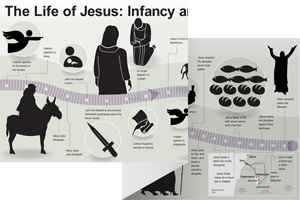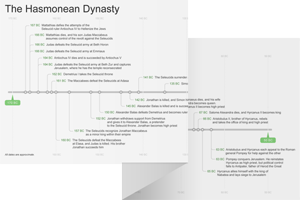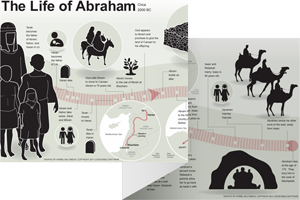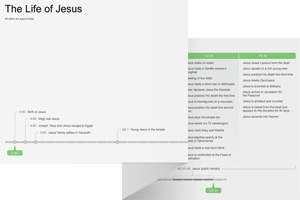1:1–17 The Gospel of Matthew |
1:1 of the genealogy Family descent was very important to Matthew’s original audience, who hoped in the promises that God had made to specific ancestors. The book of Matthew shows how Jesus fulfills these promises.
Christ The Greek word used here, christos, can be rendered as “Christ,” “Messiah,” or “anointed one.” This term is used in the ot primarily to describe kings—although other figures, such as priests and prophets, are occasionally referred to as anointed. Matthew applies the term to Jesus and connects Him with David, thereby emphasizing Jesus’ kingly role.
son of David The Jews expected the true Messiah to be from David’s line (2 Sam 7:11–16).
Abraham The forefather of Israel. God had promised Abraham that he would be the source of blessing
that he would be the source of blessing for all peoples (Gen 12:3; compare Acts 3:25; Gal 3:8). For Matthew, this promise ultimately is fulfilled in Jesus.
for all peoples (Gen 12:3; compare Acts 3:25; Gal 3:8). For Matthew, this promise ultimately is fulfilled in Jesus.
1:3 Tamar A neglected widow who used deceit in order to get her rights (Gen 38:26).
1:5 Rahab A prostitute who hid Israelite spies because she knew that Yahweh had given them the promised land (Josh 2:9). After the Israelites conquered Jericho, Rahab was protected because of the aid she gave the Israelite spies. Rahab was redeemed from both physical death and a sinful life.
Ruth The great-grandmother of King David. See Ruth 4:17 and note.
Ruth was a Moabite woman who chose to accompany her aging mother-in-law, Naomi, to Israel even though she would be a stranger there. Ruth’s devotion to Naomi resulted in her gaining a husband (Boaz) and son (Obed) and becoming an ancestress of King David (Ruth 4:21–22). Ruth’s place in Jesus’ genealogy hints at the universality of Jesus’ mission, as the law forbade Moabites from entering the Lord’s assembly (Deut 23:3). |
1:6 the wife of Uriah Refers to Bathsheba—the woman David committed adultery with (see 2 Sam 11). After she became pregnant, David arranged for her husband’s death.
1:8 Joram became the father of Uzziah Matthew omits three intervening kings (Ahaziah, Joash, and Amaziah; 1 Chr 3:11–12), possibly in order to tidy up the structure of the genealogy (see note on Matt 1:1–17).
1:11 deportation to Babylon Occurred when Nebuchadnezzar took the southern tribe of Judah into captivity in Babylon (2 Kgs 25:8–11).
1:16 of Joseph, the husband of Mary Describes Jesus’ legal descent. The culture of this time considered adoption to be real sonship. Even though Jesus had no biological relation to Joseph, He continued Joseph’s familial line.
to be real sonship. Even though Jesus had no biological relation to Joseph, He continued Joseph’s familial line.
Women in Jesus’ Genealogy | ||||
Tamar | Rahab | Ruth | Uriah’s Wife (Bathsheba) | Mary |
1:17 all the generations from Abraham to David Matthew may have omitted certain ancestors in order to highlight the important generations. He also might have used this structure to facilitate memorization: Three groups of 14 are easier to recall than a complete genealogical list.
1:18–25 The birth narrative in Matthew gives a different perspective from Luke’s (see Luke 1–2). Matthew cites several passages from the ot that show Jesus to be Israel’s long-awaited Messiah. |
 The Virgin Shall Conceive: The Vocabulary of Virginity
The Virgin Shall Conceive: The Vocabulary of Virginity
1:18 betrothed Refers to a permanent relationship nearly equivalent to marriage.
came together Refers to cohabitation or physical union.
she was found to be pregnant Suggests that Mary was in her second trimester—that is, her pregnancy was beginning to show.
1:19 not wanting to disgrace her The law demanded that an adulteress receive the death penalty (Deut 22:21). However, the Jewish community of this time often did not carry out the death penalty; instead, they punished
receive the death penalty (Deut 22:21). However, the Jewish community of this time often did not carry out the death penalty; instead, they punished adulteresses through public disgrace.
adulteresses through public disgrace.
1:20 in a dream Angelic visitation and dreams are a common means of supernatural revelation in the sacred literature of this time.
1:21 you will call his name A father was responsible for naming his son at the time of his circumcision (eight days after birth). The angel’s words implicitly command that Joseph accept his role as father of the child. In antiquity, names were often thought to be emblematic of the character or calling of the individual.
Jesus From the Hebrew name yeshua', which means “Yahweh saves.”
he will save his people from their sins Announces more than a royal or political Messiah. Jesus saves, even from sin (compare Isa 53:12).
1:22–23 The angel’s message ends in Matt 1:21, making vv. 22–23 an editorial aside. |
1:22 would be fulfilled Matthew often interprets events in Jesus’ life in terms of prophecies from the ot; this is the first instance of this type of interpretation.
 Jesus’ Fulfillment of Old Testament Prophecy Table
Jesus’ Fulfillment of Old Testament Prophecy Table
1:23 virgin The Greek word used here, parthenos, reflects the Septuagint (ancient Greek translation of the ot) version of Isa 7:14, which Matthew drew from when quoting the Hebrew Bible (or ot). Matthew appropriates this prophecy and applies it to the virgin birth of Jesus.
 The Virgin Shall Conceive: The Vocabulary of Virginity
The Virgin Shall Conceive: The Vocabulary of Virginity
call his name Emmanuel Matthew presents Jesus as the fulfillment of Isa 7:14, which says that the child’s name will be Immanuel (meaning “God with us”; compare Matt 28:20). While in the original context of Isaiah, this is a prophecy about a child born during the reign of King Ahaz of Judah (ca. 735–715 bc; Isa 7:16; compare Isa 8:8, 10), Matthew sees this prophecy as finding its ultimate fulfillment in Jesus.
(meaning “God with us”; compare Matt 28:20). While in the original context of Isaiah, this is a prophecy about a child born during the reign of King Ahaz of Judah (ca. 735–715 bc; Isa 7:16; compare Isa 8:8, 10), Matthew sees this prophecy as finding its ultimate fulfillment in Jesus.
1:25 did not have sexual relations with her Matthew does not record any command for Joseph to refrain from marital relations with Mary, although abstinence was the rule of the time during the betrothal period. Matthew is careful to indicate that no human father had any role in Jesus’ conception.
gave birth to a son The date of Jesus’ birth is approximately 5 bc, based on aligning it with the reign of Herod the Great (compare note on Matt 2:1).

|
About Faithlife Study BibleFaithlife Study Bible (FSB) is your guide to the ancient world of the Old and New Testaments, with study notes and articles that draw from a wide range of academic research. FSB helps you learn how to think about interpretation methods and issues so that you can gain a deeper understanding of the text. |
| Copyright |
Copyright 2012 Logos Bible Software. |
| Support Info | fsb |
 Loading…
Loading…





 Ruth
Ruth 